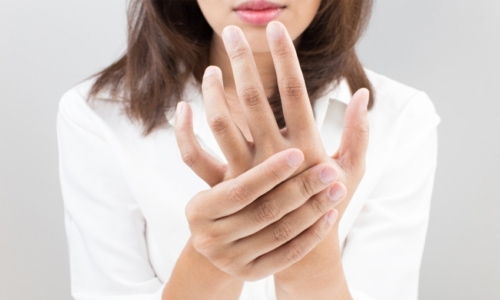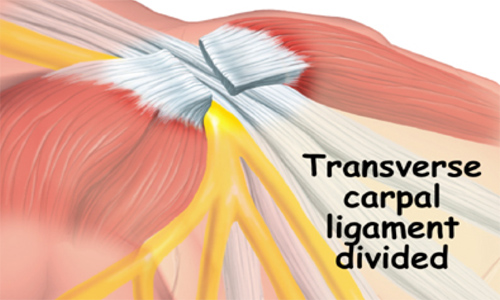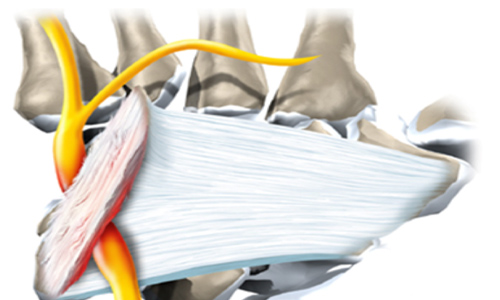Pain and numbness of fingers
Slowly increasing pain in the tips of fingers, accompanied with progressive numbness, starting in the night, later also during daytime, difficulties doing fine tasks are symptoms of irritations of the nerves, supplying to the fingers. Mainly there are two nerves: the medial and the ulnar nerve.
The medial nerve is responsible for sensibility of thumb, index, middle finger and half of the ring finger, it also sends a nerve branch to control the thenar muscles of the thumb. The ulnar nerve supplies the rest of the ring finger and the pinky finger. Branches of this nerve also supply the small muscles in the palm and the muscle that pulls the thumb toward the palm
Two areas exist on each arm where these nerves can be hurt.
The carpal tunnel, located at the connection of the fore arm and the end is one of these places. The tunnel, formed dorsal by the carpal bones and palmar with a strong and rigid ligament cannot expand. The median nerve and all the flexor tendons pass through the carpal tunnel. Any condition that makes the area inside the carpal tunnel smaller or increases the size of the tissues within the tunnel lead to a compression of the median nerve. This reduced the blood flow to the nerve, leading to loss of nerve function. Various types of arthritis can cause swelling of the tenosynovium and therefore increase pressure in the carpal tunnel. The way people do their tasks can put them at risk for increasing pressure to the nerve. Some of these risks include force, posture (condition after fracture for example), wrist alignment, repetition, temperature, vibration, but also smoking, obesity and caffeine intake. One of these risks alone may not cause a problem. But doing a task involving several factors may pose a greater risk having a problem with the nerve.
Also the ulnae nerve has its bottleneck, it is called Guyon’s canal. This tunnel is formed by two bones of the carpal row, the pisiforme and the hamate and the ligament that’s connects them. The etiology of getting a compression of the ulnar nerve which leads to similar symptoms as a carpal tunnel syndrome but at this time to the lateral fingers is mainly the same.
Before any therapy starts the diagnosis has to be proved. A nerve conduction velocity test, done by neurologists measures how fast nerve impulses move through the nerve. With this test compression and also localization of compression can be detected. Over the counter pain relievers will reduce the pain, anti-inflammatories will reduce the swelling of soft tissues and so reduce the pressure to the nerve. But if all attempts to control the symptoms fail, surgery may be suggested to reduce the pressure on the nerve.
For Carpal tunnel syndrome, it is the opening of the carpal tunnel by severing the transverse carpal ligament. This surgery easily can be done in local anesthesia at the palmar side of the wrist by incision of the skin between 1 to 2cm. The ligament will be severed under visual control. Skin will be closed by stitches. A plaster is placed and the patient can leave the clinic. Pain vanishes within the first 24h, sensibility will come back within the next weeks.
Guyon’s canal surgery needs more precautions. A tourniquet has to be placed around the upper arm so that there is no blood flow to the hand and all structures can be detected precisely. The ligament, forming the roof of Guyon’s canal can be seen and severed. Skin will be closed by stitches, a plaster is placed and the patient can leave the clinic. Restitution occurs within the following weeks.
Related Posts



